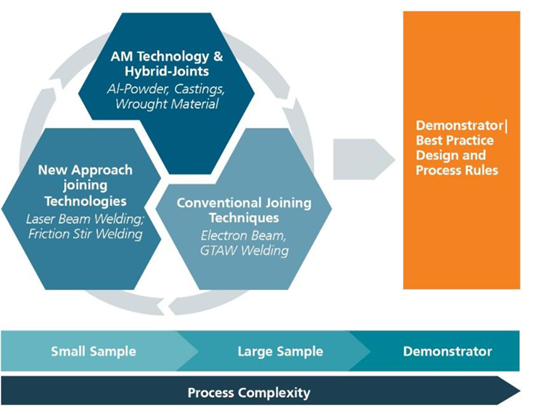WeldALAM | Innovative welding solutions for aluminium additive manufactured lightweight components
Context
One of the main cost drivers of today’s lightweight application for automotive as well as aeronautic components are costs for raw material, independent of the manufacturing routes. Complex component designs and large size parts require long lead times and the need of large production infrastructure. With respect to additive manufacturing (AM) of large aluminium parts it becomes increasingly challenging to ensure homogeneous material quality at affordable costs. AM-parts as well as Al-cast products for mass production can currently not compete with the high and repeatable material quality and low cost structure of semi-finished products, such as extrusions and sheets. That results in high effort for NDT approval of AM-parts (100% inspection) and lack of a high lightweight degree.
Using additive manufacturing technologies to produce smaller parts and to combine these with semi-finished components offer great potential to overcome the above addressed requirements and high costs for large parts. It opens the opportunity to define interfaces to connect these parts with semi-finished products by industrial well-established joining technologies, such as gas tungsten arc welding or laser welding.
Complex parts such as manifolds, heat exchangers and parts with excessive machining of complex cooling channels e.g. for aeronautic offer excellent opportunity to experience different joining techniques for additively manufactured parts. However, the existence of comparison data from standard manufactured (machined, casted or forged) and welded parts can be used for comparing properties and later on testing.
Goal and results
The focus of the WELDALAM project will be on evaluating weldability of high quality additive manufactured (AM route) high strength aluminium parts and consequently validating different welding technologies (welding route). These parts will be found in cost-sensitive, large quality AM production for automotive or alternatively in highly loaded aeronautic application for lower quantities.
Within the WeldALAM project design, material and process guidelines are being developed for industrial users, which will enable the use of welded AM components in the future.
- Design: Geometric boundary conditions are formulated for AM components which enable weldability with the EBW, GTAW, LBW and FSW processes (accessibility, distortion, tolerances) and characteristic values for component design are determined (static strength, corrosion behaviour).
- Material: The influence of the used aluminium alloy system (e.g. 5xxx, 6xxx etc.) and the heat treatment condition (as joined, heat treated) on the properties of welded aluminium AM components and the influence of the initial powder quality (virgin or recycled) on the weld porosity and joint performance will be evaluated.
- Process: Characteristic process windows are defined, which allow welding joints with sufficient quality for the selected materials with additive manufactured components.
- The boundary conditions for design, material and process should enable users to give an indication of important cost drivers and potential evaluation of the direct costs.
Approach
The approach will follow a lab-based level to explore process principles and followed by a mock-up phase for two relevant components selected together with the SMEs.
Investigations on Al-AM technology have to solve porosity issues related to hydrogen and moisture in the powder, in order to increase the part quality, e.g. for high fatigue loads. If that is shown on small samples, high speed AM build-up will be developed to reduce heat input and improve 3D quality, in order to produce prospectively cost efficient parts for serial production. Electron beam welding (EBW) will be used as reference welding technology to obtain state of the art welding seam quality. Gas tungsten arc welding (GTAW), laser beam welding (LBW) and friction stir welding (FSW) will be developed to overcome porosity and particular weldability problems. However, very narrow electron beam (EB) welds with low heat input in the workpiece but highly effort for manufacturing due to vacuum conditions and oppositely large heat input for GTAW with high distortion of parts need to be substituted. The entire investigation will be covered by non-damage inspection (NDI) methods as well as metallographic characterization of the manufactured AM parts and weld seams. Additionally surface investigations (AM parts) and corrosion test are planned to introduction in future SME relevant lightweight application.
Target Group
The WELDALAM project is oriented towards emerging markets for the production of industrial parts using additive manufacturing. The main targeted sectors within the manufacturing can be expected to be aerospace, automotive/transportation, electrical equipment and metal products. This project will also enable SMEs in the coating sector to coat AM aluminium alloys in a process-safe manner without major research costs.
Funding
- Call framework:CORNET - COllective Research NETworking





